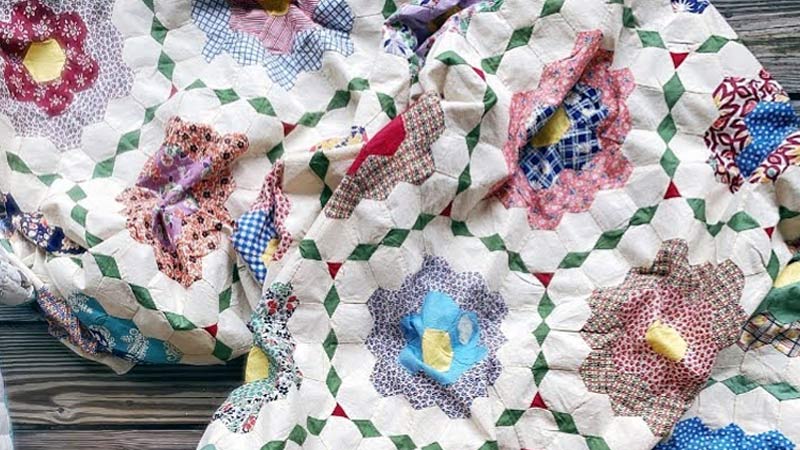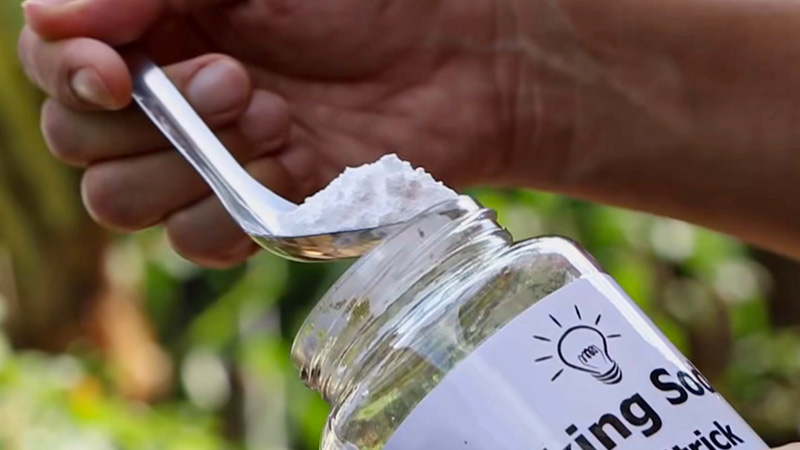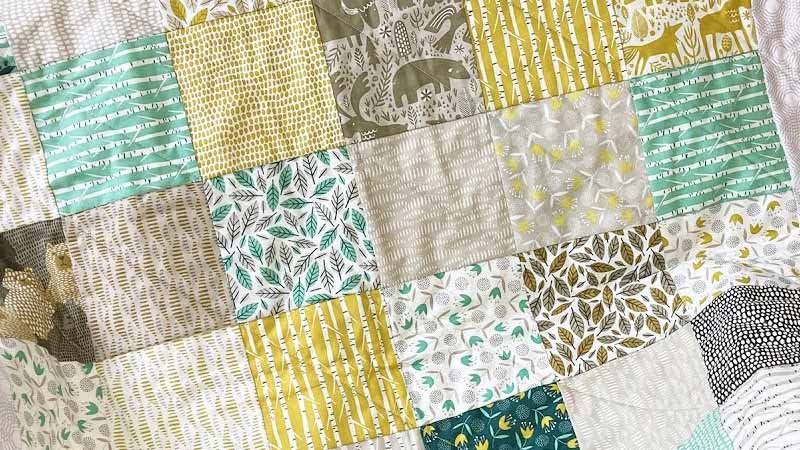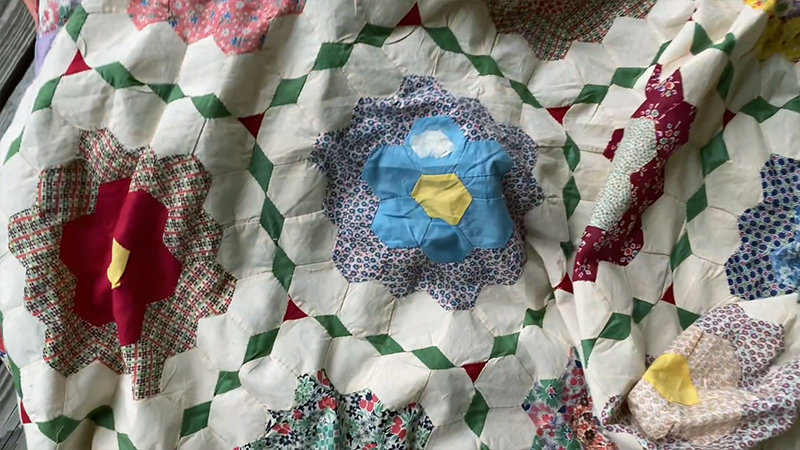Quilts often hold sentimental value, offering warmth and comfort over the years. However, they can also develop odors from various sources, such as body oils, environmental factors, or prolonged storage.
The challenge lies in preserving their coziness while eliminating unwelcome scents without subjecting them to the rigors of frequent washing.
This guide explores innovative methods and techniques to remove odors from your cherished quilt without washing effectively.
Whether you’re dealing with a vintage heirloom, a decorative masterpiece, or a well-loved blanket, these strategies will help you revive its freshness, ensuring that your quilt remains a source of comfort and nostalgia.

How to Remove Smell From Quilt Without Washing?
Removing a smell from a quilt without washing requires a delicate approach to keep the fabric and stitching intact.
Here are some effective methods to freshen up your quilt:
Spot Cleaning
Inspect the quilt meticulously for any visible stains or spots. If you notice any, create a mixture of mild detergent and water. Use a clean, white cloth or sponge to apply the solution, and gently dab the stained area.
Avoid vigorous rubbing, as it may cause damage to the fabric. Allow the spot to air dry, checking periodically to ensure the stain has been effectively lifted.
Baking Soda

Position your quilt on a clean, flat surface. Baking soda is an exceptional natural deodorizer. Sprinkle a fine, even layer of baking soda over the entire surface, focusing on areas with discernible odors.
This powdery substance works by absorbing and neutralizing unpleasant scents. Let it sit undisturbed for at least 6-8 hours or overnight for maximum effectiveness.
Afterward, use a vacuum cleaner with a soft brush attachment to gently remove the baking soda residue, eliminating all traces.
Sunlight and Fresh Air
Choose a day with ample sunshine. Find a suitable outdoor location to hang the quilt, ensuring it receives direct sunlight and fresh air.
These elemental forces are natural deodorizers. However, it’s crucial to be cautious about prolonged exposure to direct sunlight, as it can gradually fade the fabric’s colors. Rotate the quilt periodically to ensure even exposure.
Activated Charcoal
Acquire pieces of activated charcoal and place them in a breathable bag or wrap them in a porous material like cheesecloth. Activated charcoal possesses superior odor-absorbing properties due to its porous structure.
Position the charcoal pouches in the same storage area as the quilt. Over time, the charcoal will trap and neutralize any lingering odors, leaving the quilt refreshed.
Essential Oils

Select a high-quality essential oil known for its pleasant scent, such as lavender, lemon, or tea tree.
Dilute a few drops of the chosen oil in water and transfer the mixture to a clean spray bottle. Before widespread application, conduct a thorough patch test in an inconspicuous quilt area to ensure no adverse reactions occur.
Once confirmed, lightly mist the quilt with the solution. As the quilt air dries, the pleasing aroma of the essential oil will help mask any remaining odors, leaving behind a fresh scent.
Freezer Method
This method is especially effective for eliminating odors caused by bacteria. Place the quilt inside a large, sealable plastic bag, ensuring it’s tightly closed to prevent moisture from entering. Allow the bag to remain in the freezer for a few hours.
Afterward, carefully remove the quilt and let it air out in a well-ventilated area. This step is crucial for allowing any residual odors to dissipate.
Vodka Spray

In a spray bottle, mix equal parts of vodka and water. Vodka’s high alcohol content makes it an excellent natural deodorizer.
Lightly mist the quilt, ensuring an even distribution of the solution. Allow the quilt to air dry. As the vodka evaporates, it will leave behind a fresher scent.
Dryer Sheets
If possible, tuck a few unscented dryer sheets strategically between the layers of the quilt. Dryer sheets are designed to absorb and neutralize odors.
They can be particularly effective at refreshing the scent of a quilt stored for an extended period, leaving it smelling clean and revitalized.
Why Does Your Quilt Become Odorant?

When cherished quilts, imbued with memories and warmth, develop an unwanted scent, it can be perplexing.
Various factors can contribute to a quilt becoming odorant, from storage conditions to environmental exposure.
A quilt can become odorous for several reasons:
Natural Body Oils and Sweat
Our bodies naturally produce oils and sweat to regulate temperature and maintain skin health.
When we use a quilt, especially during warmer months or if we’re not wearing pajamas, these natural secretions can be transferred onto the fabric. Over time, they can build up and contribute to an unpleasant, sometimes slightly musty odor.
Accumulated Dirt and Dust
Despite regular washing and cleaning, quilts can accumulate fine dirt and dust particles.
These tiny particles can embed themselves in the fabric fibers, especially in the creases and folds, giving rise to a stale scent.
Environmental Factors
Storing a quilt in a damp or humid environment can lead to moisture absorption from the air.
This moisture can become trapped in the fabric, creating an environment conducive to the growth of mildew and mold, which produce distinct, musty odors.
Pet Dander or Hair
If pets are allowed on or near the quilt, their dander and loose hairs can settle into the fabric.
This can lead to the quilt absorbing pet-related odors, mainly if the quilt is not cleaned regularly.
Food or Drink Spills
Accidental spills of food or beverages can leave behind residues that may not be immediately noticeable. Over time, these residues can become a source of odors, especially if they’re not thoroughly cleaned.
Lack of Proper Ventilation
Quilts stored in closed or poorly ventilated spaces can trap odors and moisture.
This is particularly true in closets or storage areas with limited airflow. The lack of ventilation makes any existing odors concentrated within the fabric.
Smoking or Exposure to Strong Smells
Quilts exposed to cigarette smoke or strong odors from cooking or other activities can absorb these scents.
The fabric’s fibers retain these odors, which can persist even after the source of the smell has been removed.
Time and Use
Like any textile item, quilts wear and tear with time and repeated use.
Even with careful maintenance, they will naturally accumulate a subtle patina of everyday scents and become imbued with the essence of their environment.
Preventing Future Odors

Preventing future odors in your quilt is essential for maintaining its freshness and prolonging its lifespan.
Here are some practical steps to help you keep your quilt odor-free:
Regular Cleaning
Establish a cleaning routine for your quilt. Depending on its use, this may involve washing or airing it out regularly.
Follow the care instructions for your specific quilt type to avoid damaging the fabric.
Proper Storage
Store your quilt in a clean, dry, and well-ventilated space. Avoid damp or humid areas, as moisture can lead to mold and mildew growth, resulting in odors.
Consider using storage bags or containers to protect textiles from dust and moisture.
Sunlight and Fresh Air
Occasionally, hang your quilt outside on a sunny day to air it out. Sunlight and fresh air are natural deodorizers and can help prevent musty odors from developing.
Use of Linens or Covers
Consider using a duvet cover or top sheet if you use your quilt as bedding. These can protect the quilt from body oils and sweat, reducing the need for frequent washing.
Pets and Allergens
While you have pets, ensure they don’t sleep on or come into direct contact with your quilt. Pet dander and hair can contribute to odors and allergens. Consider using a lint roller or fabric brush to remove any pet hair.
Regular Vacuuming
If your quilt is used decoratively, vacuum it periodically with a low-suction setting and a soft brush attachment to remove dust and particles that may lead to odors.
Storage with Odor Absorbers
When storing your quilt, place odor absorbers like activated charcoal or baking soda in the storage container or bag to help prevent odors from developing over time.
Proper Washing Techniques
When you do need to wash your quilt, follow the manufacturer’s care instructions closely. Use a gentle detergent and avoid overloading the washing machine to ensure thorough cleaning.
Refrain from Using Strong Scents
Avoid using strong perfumes, fragrances, or air fresheners near your quilt, as they can leave behind residual scents that may be unpleasant when combined with the quilt’s natural odor.
Rotate Quilts
If you have multiple quilts, rotate their use to prevent one quilt from accumulating excessive odors. This also helps distribute wear and tear more evenly.
Professional Cleaning
Consider having your quilt professionally cleaned every few years or as needed, especially if it’s valuable or delicate.
Professional cleaners have the expertise to handle quilts carefully and effectively remove embedded odors.
When You Need to Consult with Professional Quilt Restorers?

Consulting with professional quilt restorers is essential when dealing with valuable, antique, or sentimentally significant quilts.
Here are specific situations that warrant the expertise of a professional:
Antique Quilts
Quilts considered antique (typically over 100 years old) often require specialized care.
Their delicate fabrics and intricate stitching may be fragile and need restoration by a professional with experience handling historic textiles.
Extensive Damage
Quilts that have suffered extensive damage from water damage, pests, or general wear and tear may require professional intervention.
This can include repairing tears, patching holes, and stabilizing weakened areas.
Historically Significant Quilts
Quilts with historical importance, such as those associated with specific events, individuals, or cultural movements, should be entrusted to experts.
They possess the knowledge and skills to ensure these quilts are preserved appropriately.
Intricate Needlework
Quilts with intricate needlework, delicate lace, or detailed appliqué work demand specialized care.
Professional quilt restorers have the expertise to handle these fragile elements with precision.
Fabric Deterioration
Quilts that have experienced color fading or fabric deterioration may require dye restoration or careful reinforcement of weakened areas. This task is best left to professionals who understand the nuances of fabric conservation.
Preserving Family Heirlooms
Quilts passed down through generations often carry sentimental value. If a family heirloom quilt requires restoration, consulting a professional ensures it’s done with the utmost care and respect for its heritage.
Valuable or Collectible Quilts
Quilts with significant monetary value or those sought after by collectors should be restored by professionals who understand the market and can ensure the quilt is preserved to maintain or enhance its value.
Matching Historical Techniques
Restoring quilts to their original condition may require using historical techniques, such as hand-stitching or specific fabric treatments. Professional restorers are skilled in replicating these methods.
Authentication or Appraisal
If you’re uncertain about the authenticity or value of a quilt, consulting a professional can provide you with an accurate assessment. They can also assist in documenting the quilt’s provenance.
Preserving Cultural Heritage
Quilts that hold cultural significance, such as those representing a particular region or tradition, may require restoration by experts familiar with the cultural context and techniques.
FAQs
Can I use baking soda to remove the odor from my quilt?
Yes, baking soda is an effective natural deodorizer. Sprinkle a generous amount over the quilt’s surface, let it sit for a few hours, and then vacuum it off.
Is it safe to use essential oils on my quilt to eliminate odors?
Yes, essential oils can be used to freshen up a quilt. Mix a few drops of water in a spray bottle and lightly mist the quilt. Allow it to air dry.
Can I use activated charcoal to absorb odors from my quilt?
Absolutely! Placing activated charcoal in a breathable fabric bag or sock and leaving it near the quilt will help absorb unwanted smells.
How can I remove odor using sunlight and fresh air?
Hanging the quilt outdoors on a sunny, breezy day can help naturally freshen it up. Ensure it’s not in direct sunlight for too long to prevent fading.
Is freezing an effective method for removing odors from a quilt?
Yes, freezing can help eliminate some odors. Place the quilt in a large plastic bag and put it in the freezer for a few hours. Let it air out afterward.
Wrap Up
Removing odors from a quilt without washing is possible with a few simple methods.
First, spot-clean any visible stains using a gentle fabric cleaner. Next, sprinkle baking soda liberally over the quilt’s surface and let it sit for several hours or overnight to absorb odors.
Vacuum the baking soda thoroughly. For persistent smells, place the quilt in a well-ventilated area and allow it to air out for a few days, preferably in the sunshine.
Additionally, using odor-neutralizing products like activated charcoal or sachets of dried lavender can help refresh the quilt. Regularly airing out and proper storage can prevent future odor issues, keeping your quilt fresh and cozy.
Leave a Reply